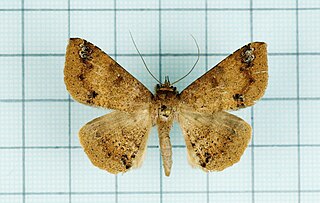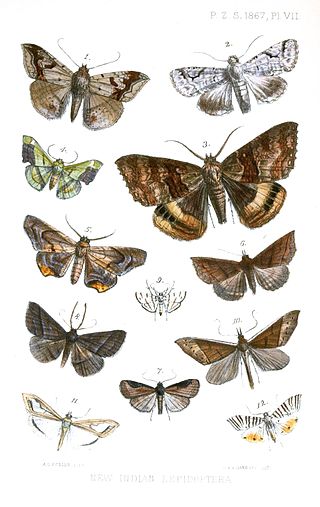
The Calpinae are a subfamily of moths in the family Erebidae described by Jean Baptiste Boisduval in 1840. This subfamily includes many species of moths that have a pointed and barbed proboscis adapted to piercing the skins of fruit to feed on juice, and in the case of the several Calyptra species of vampire moths, to piercing the skins of mammals to feed on blood. The subfamily contains some large moths with wingspans longer than 5 cm (2 in).

Ugia is a genus of moths in the family Erebidae erected by Francis Walker in 1858.

Ericeia is a genus of moths in the family Erebidae. The genus was erected by Francis Walker in 1858.

Mocis is a genus of moths in the family Erebidae. The genus was erected by Jacob Hübner in 1823.

Ericeia subsignata is a moth of the family Erebidae. It is known from Australia, including the Australian Capital Territory.

Ericeia inangulata, the sober tabby, is a moth in the family Erebidae. The species was first described by Achille Guenée in 1852. It is found in the Indo-Australian tropics of China, India, Sri Lanka, Myanmar, and the Marianas and Carolines, Fiji, Vanuatu, New Caledonia and Samoa.
Ericeia congressa is a moth in the family Erebidae. It is known to be found in South Africa, Madagascar, Mauritius and Réunion. It was described by Francis Walker in 1858.
Ericeia elongata is a moth in the family Erebidae. It is found from the Indo-Australian tropics to New Guinea and Australia (Queensland). The habitat consists of lowland forests, including heath and alluvial forests.
Ericeia sobria is a moth in the family Erebidae. It is found in Kenya, South Africa, Gambia, Borneo, New Guinea and Australia, where it has been recorded from Queensland and New South Wales.
Ericeia congregata is a moth in the family Erebidae. It is found in Angola, Cameroon, Cape Verde, the Comoros, the Democratic Republic of Congo, Gabon, Kenya, La Réunion, Madagascar, Mauritania, Mauritius, Sierra Leone, South Africa, Gambia, Uganda, Yemen, Saudi Arabia, India and Sri Lanka.

Ericeia amanda is a moth in the family Erebidae. It is found on Borneo, Sumatra and Peninsular Malaysia. The original description notes Adelaide, Australia as type locality, but the species is not known from Australia.

Bamra albicola is a moth of the family Noctuidae first described by Francis Walker in 1858.

Anomis mesogona is a moth of the family Erebidae first described by Francis Walker in 1857. It is found in India, Sri Lanka, Somalia and Japan.









